#Peter McGill
Explore tagged Tumblr posts
Text
The Dark Shadow Cast by Moon Sun Myung’s Unification Church and Abe Shinzo (Part 2)
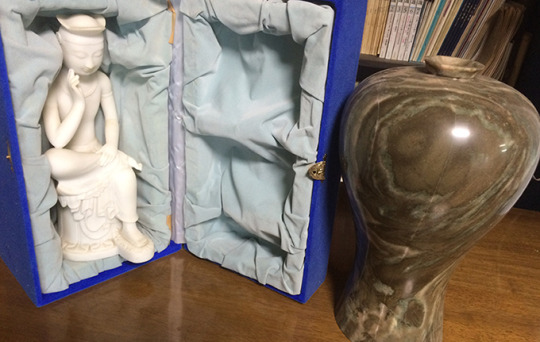
▲ Maitreya ‘future Buddha’ statue and marble vase – both made in UC factories in Korea – for sale at vastly inflated prices.
Asia Pacific Journal | Japan Focus Peter McGill October 15, 2022
Concealment and Deception One of many charges made against the Unification Church is its lack of candour about numerous front groups, often given titles offering no clue as to their cult origins.
In Japan, recruitment and fund-raising have frequently involved concealment and deception. Sakurai says this has been necessary to hide both the Judaeo-Christian elements of the Moon cult in a country that lacks any monotheistic tradition, and its lacing with Korean nationalism. Recruiters “don’t disclose who they are but aim first at establishing a strong emotional relationship,” he notes. Elderly Japanese and housewives are particularly vulnerable to a strategy that employs fortune-telling and ancestor worship.
Moon’s boldest subterfuge in the late 1980s was to establish a Buddhist cult called Tenchi Seikyo (‘True teachings of heaven and earth’) to wring more money out of Japan. A ‘clandestine convergence’ of ‘traditional Japanese folk Buddhism’ with the Christian messianism of the Unification Church, Tenchi Seikyo met the expedient requirement for ‘a more direct fund-raising and witnessing approach within a predominantly Buddhist country,’ Thomas H. Pearce noted in a paper.2 The forerunner of Tenchi Seikyo was started in Hokkaido in the late 1950s by a charismatic spiritual medium, Kawase Kayo.
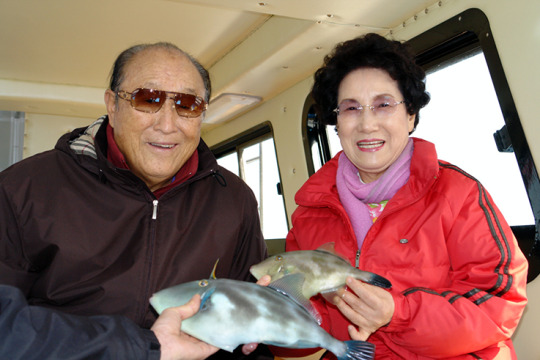
▲ Kawase Kayo with Sun Myung Moon
Her cult’s object of worship was the Maitreya ‘future Buddha’ (Miroku Bosatsu 弥勒菩薩). In the early 1970s, she secretly joined the Unification Church, but did not announce this to her followers, who continued to worship Miroku Bosatsu. This did not trouble Kawase, as according to Moon’s syncretic doctrine, the Korean messiah could also be Buddha:

▲ Moon as Maitreya Buddha ‘Naturally, the Lord of the Second Advent [i.e., Moon], who comes as the central figure of Christianity, will also play the role of Buddha, whom Buddhists believe will come again, as well as the role of the “True Man” whose appearance Confucianists anticipate, and “Chung Do Ryung” (“Herald of the Righteous Way”), whom many Koreans expect to come. In addition, he will also play the role of the central figure whom all other religions await.’ (‘Divine Principle,’ 1973) Kawase founded Tenchi Seikyo after receiving a “heavenly message” in 1987. The messenger was a young African who had belonged to the Unification Church in Zimbabwe. Cultists believed him to be the incarnation of ‘Lord’ Heung Jin, the second son of Moon who died in a car accident in 1986. During a visit to Japan, the African Heung Jin instructed Kawase to obtain legal status for a new Miroku church.
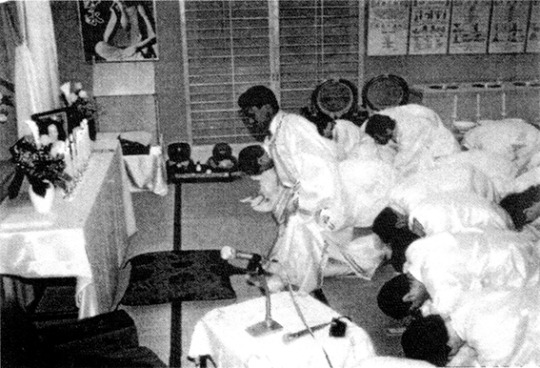
▲ Cleopas Kundiona at a Tenchi Seikyo dojo in Japan
‘Within months,’ the Unification Church ‘had organised Tenchi Seikyo centres throughout the country. Thousands of members and a large amount of money were invested in creating this new organization.’ In the 1990s, out of 111,000 followers of Tenchi Seikyo, only 8,000 had been informed that the Miroku Bosatsu they were worshipping was actually Moon Sun Myung. Members of the Unification Church were in charge of running the Tenchi Seikyo centres, known as dojo, and they all believed that Moon was Miroku Bosatsu,’ while their ‘core concern’ was that Moon needed ‘money and members to save the world.’ Pearce was told by an officer of Tenchi Seikyo that his cult had made ‘very large contributions to Moon.’
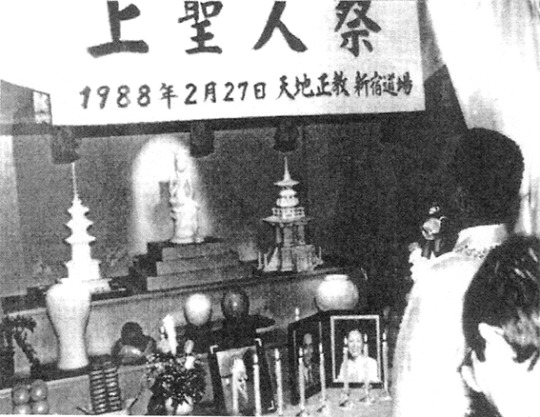
▲ Cleopas Kundiona at a Tenchi Seikyo dojo in Japan. Note the miniature pagodas and the marble vases.
In order to peddle Unification Church products, such as marble vases, miniature marble pagodas, ivory inkan seals, Buddhist prayer beads and ginseng tea, Japanese consumers first had to be won over.
Typical Moonie approaches to Japanese strangers have included “Please cooperate in this questionnaire into youth consciousness,” or “I am studying palm reading. There are stress lines in your hand that indicate a transition period.” Bit by bit, they drew out personal worries, and family and financial misfortunes.
Pearce interviewed a Unification Church female member who claimed to be a trainee monk and gained entry to Japanese homes by promising to read a householder’s fortune. The kanji characters of the victim’s name inevitably would indicate trouble in the spirit world, but this could be rectified by buying a new inkan seal. After the order was placed, the Unificationist would continue to visit the house and give instructions on worship at the family altars, so that the ancestral curse would be lifted. Once the inkan arrived, the target would be invited to a showroom for the sale of marble vases.
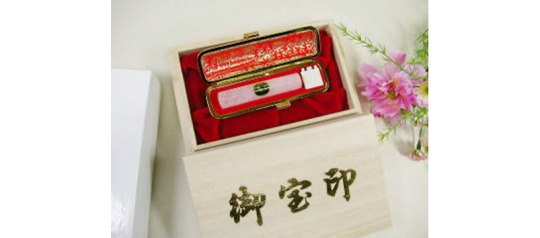
▲ Inkan name seal
Remedies from bad karma, “to free you from the fateful destiny of ancestors,” were all exorbitantly expensive. One bottle of concentrated ginseng extract was peddled for ¥80,000. A carved pagoda would set you back ¥5.4 million. Missionaries scanned death notices to identify the recently bereaved, who were then offered special communication channels to the spirit world in return for a sizeable donation.
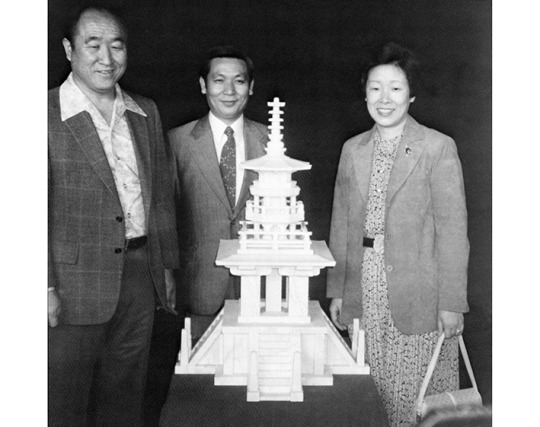
▲ Sun Myung Moon and Hak Jan Han with a miniature pagoda. They claimed they knew nothing about the pagoda scam in Japan.
The Unification Church has defended such fraudulent practices. “Imagine that one of our ancestors committed a sin in his life and is now in hell, but let’s say he can ascend to heaven from hell through our ancestor donations. He can be freed from hell. How great is this?” spokesman Ahn told the Al Jazeera news channel in 2012.
The Asian financial crisis of 1997-8 dealt a heavy blow to Unification Church finances. In 2005, Moon’s fourth son Kook Jin, who has an MBA from the United States, was put in charge of restructuring the Tongil (‘Unification’) Group, the church’s business empire in Korea.
In 2012, Moon Kook Jin told a Unification Church assembly in Seoul that the cult had “fought a very difficult battle against the Japanese government’s persecution of our church” and had “prevented the government from closing our church down.” Both membership and income in Japan had posted healthy growth, he assured cult members. Net membership in Japan increased by “15,000” in three years and debt incurred from settling legal claims had been cut by more than $300 million. “We are doing just fine,” he assured.
If confirmed, this increase in membership may be linked to targeting of Zainichi ethnic Korean permanent residents, who either immigrated to Japan before 1945 or are descended from them.
According to Sakurai of Hokkaido University, most members of the Unification Church in Japan “are ordinary Japanese.” However, in 2005 the Public Security Intelligence Agency reported that a “unique group” had established “a new organization with the purpose of gathering Koreans living in Japan and that exhibited attempts to extend its influence by incorporating these Zainichi Koreans and affiliated parties” and was “inciting a sense of danger and anxiety” to expand its power. The following year, the agency added that the group “advocates the unification of the Korean Peninsula and has made moves to create friction with Zainichi organizations by making Zainichi Koreans and affiliated parties attend gatherings in South Korea and through other means." In response to opposition questions in the Diet, the Cabinet clarified on August 15 that this “unique group” being monitored was the Unification Church. It was categorised as unique because of “doctrines and claims that deviate from social norms.”3
A huge Moon Church scam in Japan is revealed
#unification church#sun myung moon#hak ja han#ffwpu#UC of Japan#Peter McGill#Kawase Kayo#Tenchi Seikyo
0 notes
Text





New photocards/toploaders I made yesterday night 🎶🌀
#ghostbusters#deco#photocards#deco toploader#photocard#top loader#jimmy mcgill#better call saul#winston zeddemore#peter venkman#stickers#sticker deco
50 notes
·
View notes
Text




Peter is weirdly fitting for Jimmy
#my art#digital art#doodle#sketch#breaking bad#saul goodman#jimmy mcgill#peter b parker#astv#itsv#fanart
184 notes
·
View notes
Photo
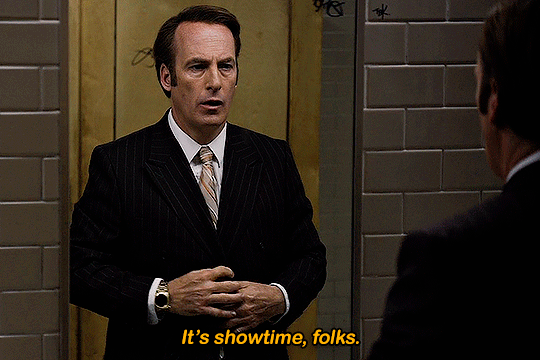




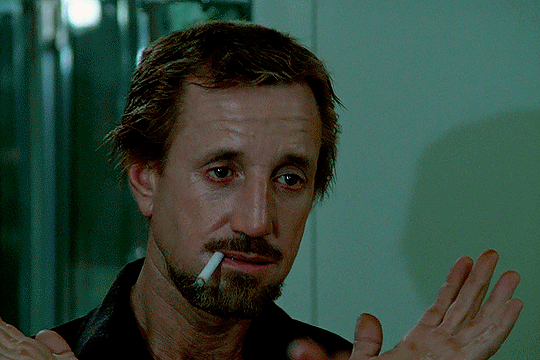
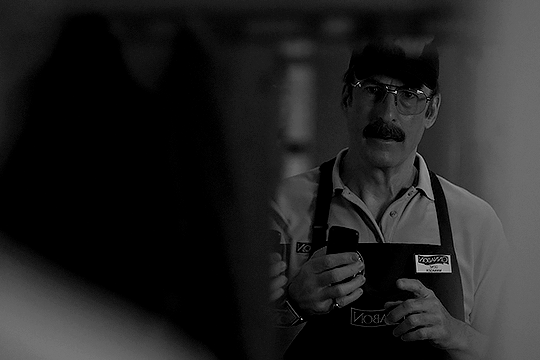
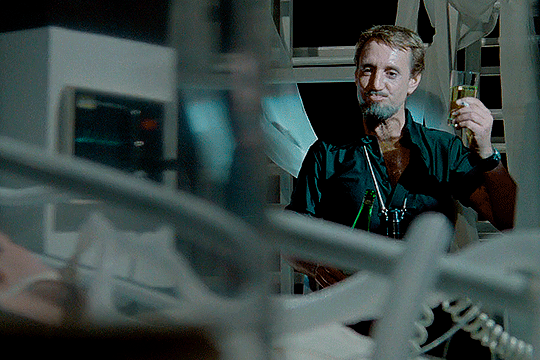

BETTER CALL SAUL by Vince Gilligan and Peter Gould (2015-2022) // ALL THAT JAZZ, dir. Bob Fosse (1979)
#concerto alla rustica is playing in the background
#it's showtime folks!#better call saul#bcs#bcsedit#all that jazz#filmedit#tvedit#jimmy mcgill#saul goodman#vince gilligan#peter gould#bob fosse#bcs 1.02#bcs 6.10#bcs 6.13#cinematv#moviegifs#tvgifs#dailyflicks#tvfilmsource#poetic cinema#my gifs#my edit
890 notes
·
View notes
Text










Better Call Saul Season 1
Source: breakingbad.fandom.com
#better call saul#saul goodman#jimmy mcgill#vince gilligan#peter gould#bcs#breaking bad#chuck mcgill#howard hamlin#mike ehrmantraut#kim wexler#tuco salamanca
27 notes
·
View notes
Text

Posted by Tony on IG. Hollywood Legion Theater
Better Call Saul premiere last night. #bettercallsaul
#Tony Dalton#daltonyco#2022#IG post#Mark Margolis#Hector Salamanca#Jonathan Banks#Mike Ehrmantraut#Peter Gould#Michael Mando#Nacho#Nacho Varga#Ignacio Varga#Vince Gilligan#Giancarlo Esposito#Gus#Gustavo Fring#Rhea Seehorn#Kim Wexler#Bob Odinkirk#Jimmy McGill#Saul Goodman#Patrick Fabian#Howard Hamlin#red carpet#Better Call Saul#premiere
31 notes
·
View notes
Photo
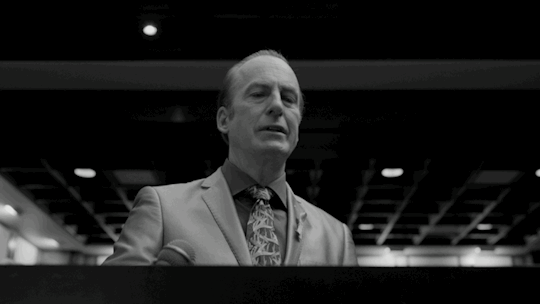




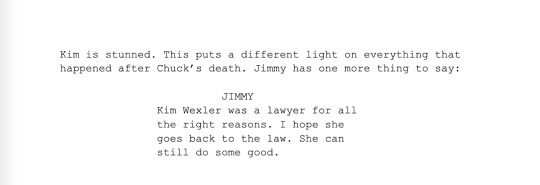

“This is the guy she fell in love with.”
Better Call Saul 6.13 “Saul Gone”
written by Peter Gould
367 notes
·
View notes
Text
going to go crazy. better call saul transformed throwaway lines from breaking bad into two fully formed and fleshed out characters that haunt jimmy/saul’s narrative throughout the entire run of both shows. it wasn’t me, it was ignacio! it was nacho varga, first a willing participant in the salamanca game and then a victim and a pawn in gus fring’s revenge plot against them. who was forced to bring an end to lalo salamanca’s life but enjoyed it nonetheless. lalo, lalo didn’t send you? lalo salamanca, brought into jimmy/saul’s world by ignacio, who struck fear into jimmy and sent him on a days long trek through the desert. who knew the name of jimmy’s wife. who seemingly arose back from the dead and appeared in his doorway, shooting howard hamlin and permanently changing the course of jimmy’s life. one of the dominoes that fell to create saul goodman. ignacio and lalo, who lived in saul’s brain always, that when he was kneeling over an open grave in the desert, those were the only two names he could utter desperately. throwaway lines in breaking bad to necessary and transformative characters in better call saul. goodbye world
#olivia’s corner#bravo peter & bravo vince#feeling sick and insane about the lawyer show today#better call saul#breaking bad#jimmy mcgill#saul goodman#lalo salamanca#nacho varga
318 notes
·
View notes
Text
Using Better Call Saul and Doctor Who as empirical data, I hypothesise that the more unhealthily attached and worse two people in a heterosexual relationship get in a piece of media, the more gay people are attracted to it like moths to a lamp.
Yes I’m the gay person and yes this is about McWexler and 12Clara
#doctor who#better call saul#peter capaldi#jenna coleman#12clara#clara oswald#12th doctor#twelfth doctor#jimmy mcgill#kim wexler#rhea seehorn#saul goodman#mcwexler#bob odenkirk
49 notes
·
View notes
Text
This stylish thriller from 2004 is seriously underrated.
The dialogue throughout this movie is smart, brutal and 'off the chart'.

#collateral 2004#thriller movies#tom cruise#jamie foxx#jada pinkett smith#mark ruffalo#bruce mcgill#Peter berg#barry shabaka henley#javier bardem#jason statham#movie classics#classic movies#movie#movies#movie nerd#movie night#movie review#movie poster
14 notes
·
View notes
Text
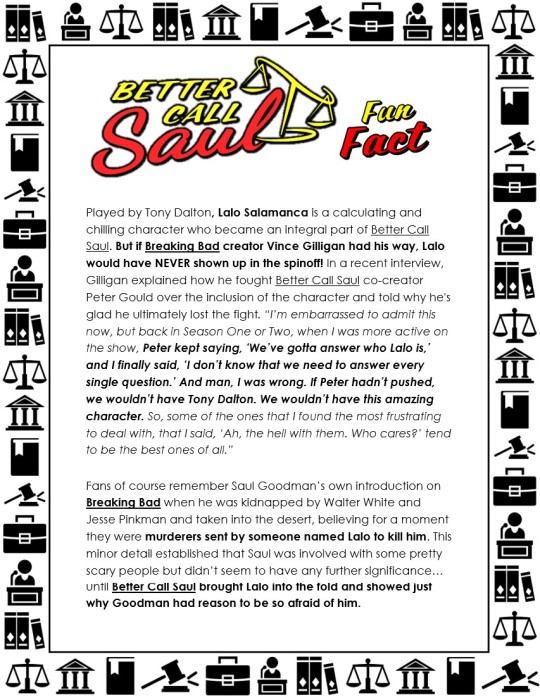

youtube
youtube
Lalo Salamanca was NEVER supposed to be in Better Call Saul! 😯
#breaking bad#brba#better call saul#bcs#saul goodman#jimmy mcgill#lalo#lalo salamanca#tony dalton#peter gould#vince gilligan#tv#tv show#tv shows#tv series#tv trivia#trivia#fun fact#fun facts#did you know#Youtube
74 notes
·
View notes
Text
The Dark Shadow Cast by Moon Sun Myung’s Unification Church and Abe Shinzo (Part 1)
Asia Pacific Journal | Japan Focus Peter McGill October 15, 2022
Abstract: The killing of Abe Shinzo sparked a backlash in Japan against the Unification Church, after the assassin blamed it for his family’s destitution and linked the former prime minister to the Korean cult. This has led to a government investigation of the Unification Church, popularly known as the Moonies, that may result in its disbandment in Japan. The scandal has focused attention on the vital role played by Japan in financing the sect founded by Moon Sun Myung, and the strange history that spawned a global empire swaddled in taboo.
The July 8 slaying of Abe Shinzo on the streets of Nara has spawned unexpected consequences. Public reaction in Japan whipsawed from shock and grief at the former prime minister’s tragic death to anger and disgust at longstanding ties between the ruling Liberal Democratic Party and the Unification Church. On October 17, Prime Minister Kishida Fumio announced a government investigation of the Unification Church that may lead to the dissolution of its Japanese branch.
Yamagami Tetsuya, the former navy officer and unemployed man who fatally shot Abe from behind with a homemade gun, told police that his family had been left destitute, and his own life blighted, by his mother’s huge donations to the Korean cult founded by Moon Sun Myung. In Yamagami’s disturbed mind, Abe’s political embrace of the Unification Church made him a legitimate target for revenge.
On July 16, the Japanese tabloid Nikkan Gendai, which had been the first to report that Yamagami’s mother belonged to the Unification Church, published a list of 111 other members of the Diet (parliament) who shared Abe’s links to the cult. The list was compiled by journalist Suzuki Eito, a specialist in tracking cults in Japan.
Japanese media critical of the LDP and of Abe’s right-wing nationalism, most notably the Asahi and Mainichi dailies, doggedly pursued the scoop, and there has been an almost constant stream of press conferences and stories that have inflicted serious damage to the Unification Church in Japan, and acutely embarrassed the mainly conservative politicians who associated with it. On September 8, the LDP released the results of an internal survey, showing that almost half of its 379 Diet members had admitted to dealings with the cult. In addition, 290 members of prefectural assemblies and seven prefectural governors have acknowledged association with it, according to a survey by the Asahi.
Japanese Moonies are not so numerous as to constitute a significant voting bloc. Sakurai Yoshihide, a professor of sociology at Hokkaido University and an expert on Japanese cults and new religions, says their main political value is as a source of volunteers to help favoured candidates in election campaigns. Abe had recommended that members of his Seiwa-kai faction take advantage of such offers.
Prime Minister Kishida Fumio hastily announced a state funeral for Abe, the Moonies’ most valuable ally in Japan, soon after the assassination. Since then, the deluge of reporting about the Unification Church helped shift Japanese public opinion against the state funeral which took place on September 27 with a cost to taxpayers of ¥1.25 billion. Kishida’s popularity slumped, and the October announcement of a probe into the Unification Church has been seen as a means to boost his standing in opinion polls. Japanese Fund a Global Empire Japan has been crucial to the growth of the Unification Church. The former colonial power, which ruled the Korean peninsula from 1910 to 1945, has twice the number of Moonies as its home country - 300,000 compared to between 150,000 and 200,000 in South Korea, according to spokesman Ahn Ho-yeul – and ever since the 1970s, has provided the lion’s share of the church’s global income.
In 1984, the Washington Post was told by two renegade former officials of the Unification Church in Japan that from 1975 to 1984 it had transferred at least US$800 million to the United States, to finance a myriad of the cult’s businesses, publications, and political operations, including the money-draining Washington Times newspaper.1

Most of the money came from gullible and superstitious Japanese who were peddled marble vases, ivory seals, and miniature pagodas said to have miraculous powers, along with ginseng teas, at vastly inflated prices. Japanese members of the cult were given sales quotas requiring them to transfer to the United States about $2.5 million a month earmarked for the Washington Times, which lost an estimated $150 million in its first two-and-a-half years of operation, according to Soejima Yoshikazu. Soejima had been editor of the cult’s Japanese newspaper, Sekai Nippo, but was fired on Moon’s orders for attempting editorial independence. A gang of toughs from the Unification Church, led by members of the affiliated anti-communist group Kokusai Shokyo Rengo, ransacked the newspaper office, and beat him up, according to Soejima. Then in June 1984, Soejima was attacked outside his Tokyo home and repeatedly stabbed. At the time, he had been preparing an article critical of Moon for Bungei Shunju magazine.
In 1987, the Asahi calculated there had been 15,000 complaints since 1980 of Japanese citizens being defrauded by Unification Church members, through total purchases amounting to ¥317 billion. A national network of lawyers to combat reikan shoho (霊感商法, selling of spiritual goods) was set up.
The Japanese backlash forced the Unification Church to curtail unscrupulous sales in favour of pressuring Japanese members to make donations. These were often linked to fundraising projects of Moon Sun Myung, such as the construction of a tunnel between Japan and Korea (since stalled), car factories in North Korea and China, and a 1,200-hectare “Peace Park” at Moon’s birthplace.
The new donation strategy reportedly led to a substantial increase in financial demands placed upon Japan. Sakurai Masaue, a disillusioned former cult official, told the Mainichi that in the two decades before he quit in 2017, the Unification Church in Japan had an annual fund-raising target of around ¥30 billion, or $209 million. The extreme burden placed on Japanese members pushed many into bankruptcy, he said.
Offspring of Japanese duped into handing over their life savings or retirement money to the Unification Church have given harrowing testimony; none more so than that of Yamagami, the alleged assassin of Abe, whose hatred of the cult festered as his family was dragged into poverty.
Yamagami was four years old when his father, a site director of a tunnel construction firm, killed himself. Seven years later, his mother joined the Unification Church and started making huge donations that eventually bankrupted her and compelled Yamagami to drop out of university. His brother later committed suicide.
“After my mother joined the church, my entire teenage years were gone, with about ¥100 million wasted,” Yamagami wrote in a letter. “It’s no exaggeration to say my experience during that time has kept distorting my entire life.”
Upon joining the Unification Church in 1991, his mother turned over ¥50 million she had received from her late husband’s life insurance policy. When her own father died in 1998, she became head of his construction company, but five months later sold a house she had inherited and gave more than ¥40 million to the cult. In 2002, she was declared bankrupt but continued giving money to the cult. Yamagami’s paternal uncle said he used to receive telephone calls from the three children complaining of having nothing to eat. He finally halted financial support because their mother was just handing over his money to the Unification Church. When Yamagami tried to commit suicide in 2005, she opted to stay in South Korea on a church mission.
これが『統一教会』の秘部だ
0 notes
Text
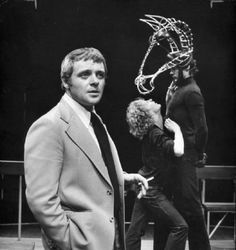

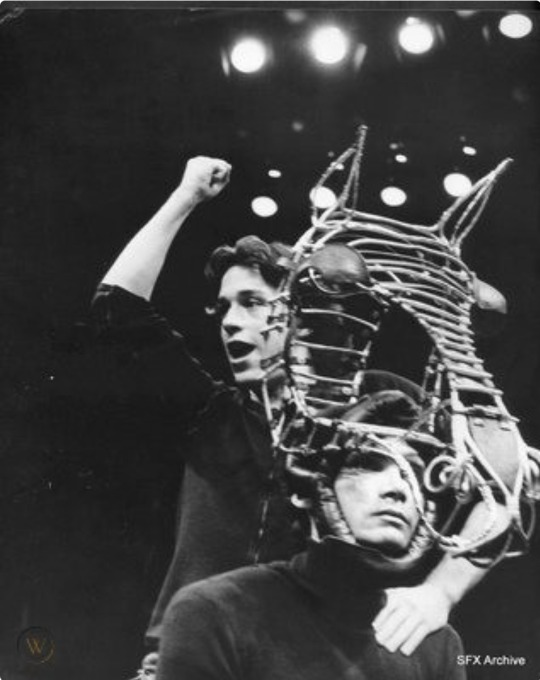


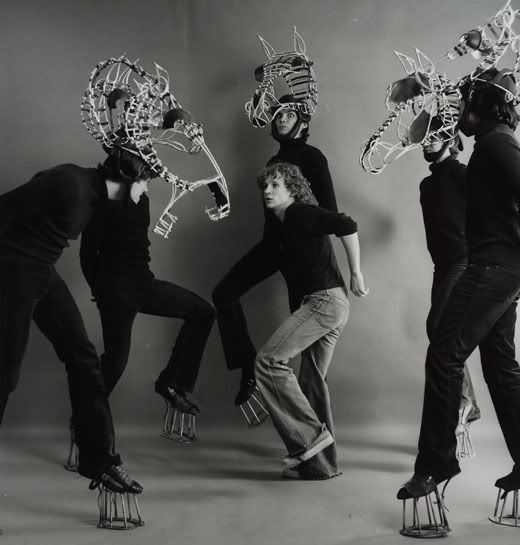

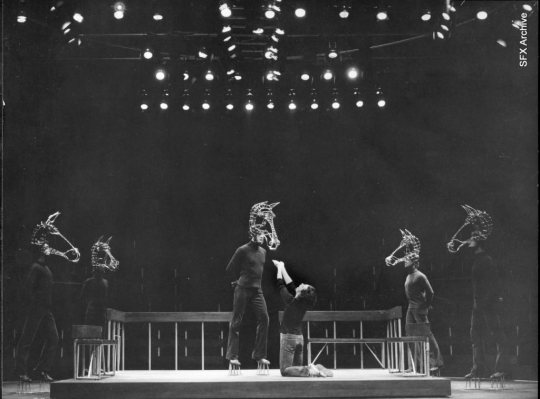

Everett McGill as Nugget the Horse, with Anthony Hopkins, Anthony Perkins, and Peter Firth in the original 1973 to 1975 run of Equus
#I don't even know what to add here that would possibly make this trivia wilder#Everett McGill#Twin Peaks#Anthony Hopkins#Anthony Perkins#Peter Firth#Equus#big ed's gas farm
128 notes
·
View notes
Text

#Collateral#Tom Cruise#Jamie Foxx#Jada Pinkett Smith#Mark Ruffalo#Peter Berg#Bruce McGill#Michael Mann#2004
12 notes
·
View notes
Text

Better call Saul - (2015/2022)
#better call saul#illustration#film#bob odenkirk#saul goodman#jimmy mcgill#rhea seehorn#kim wexler#vince gilligan#peter gould
122 notes
·
View notes
Text
I really do like it when attractive men are put in situations
28 notes
·
View notes